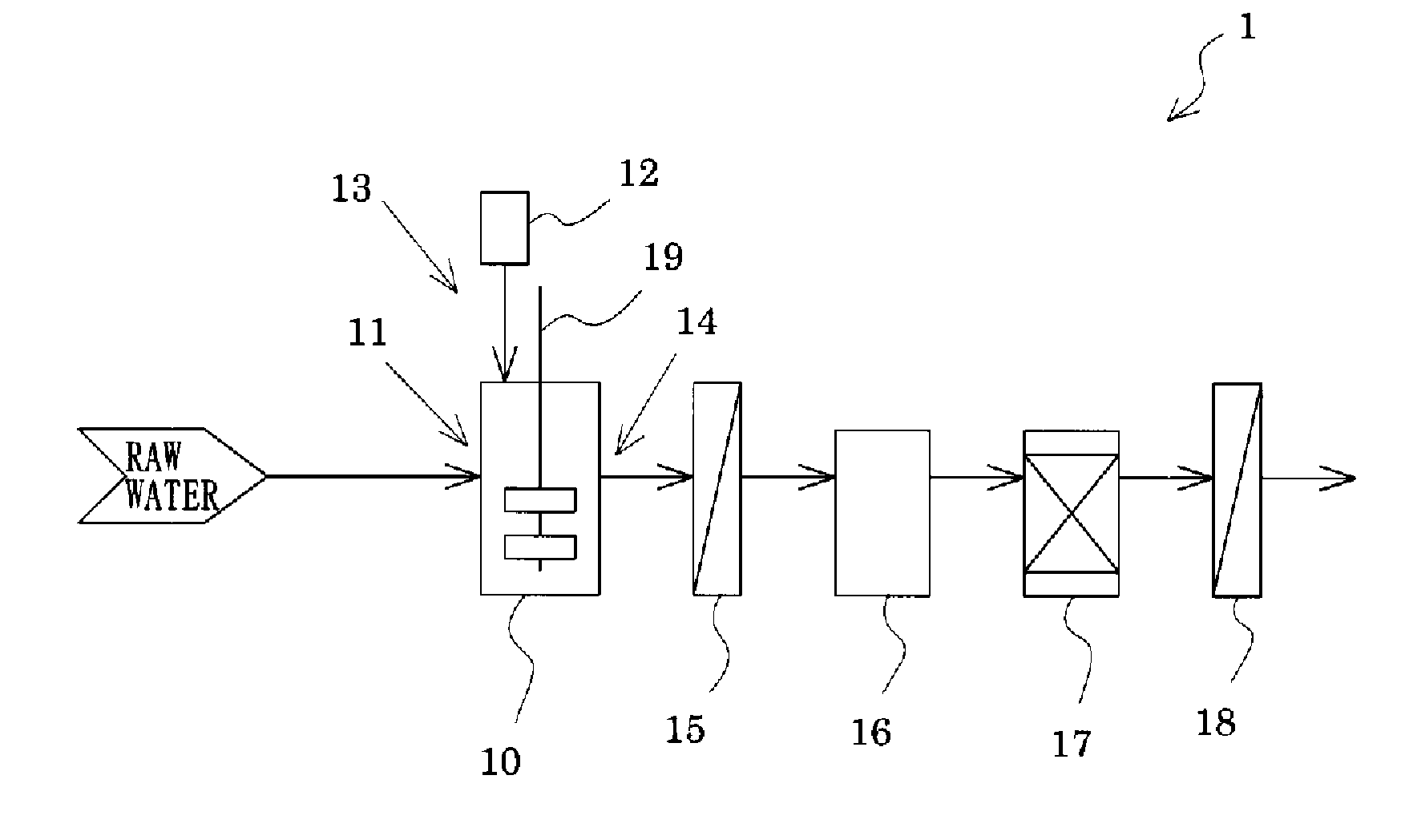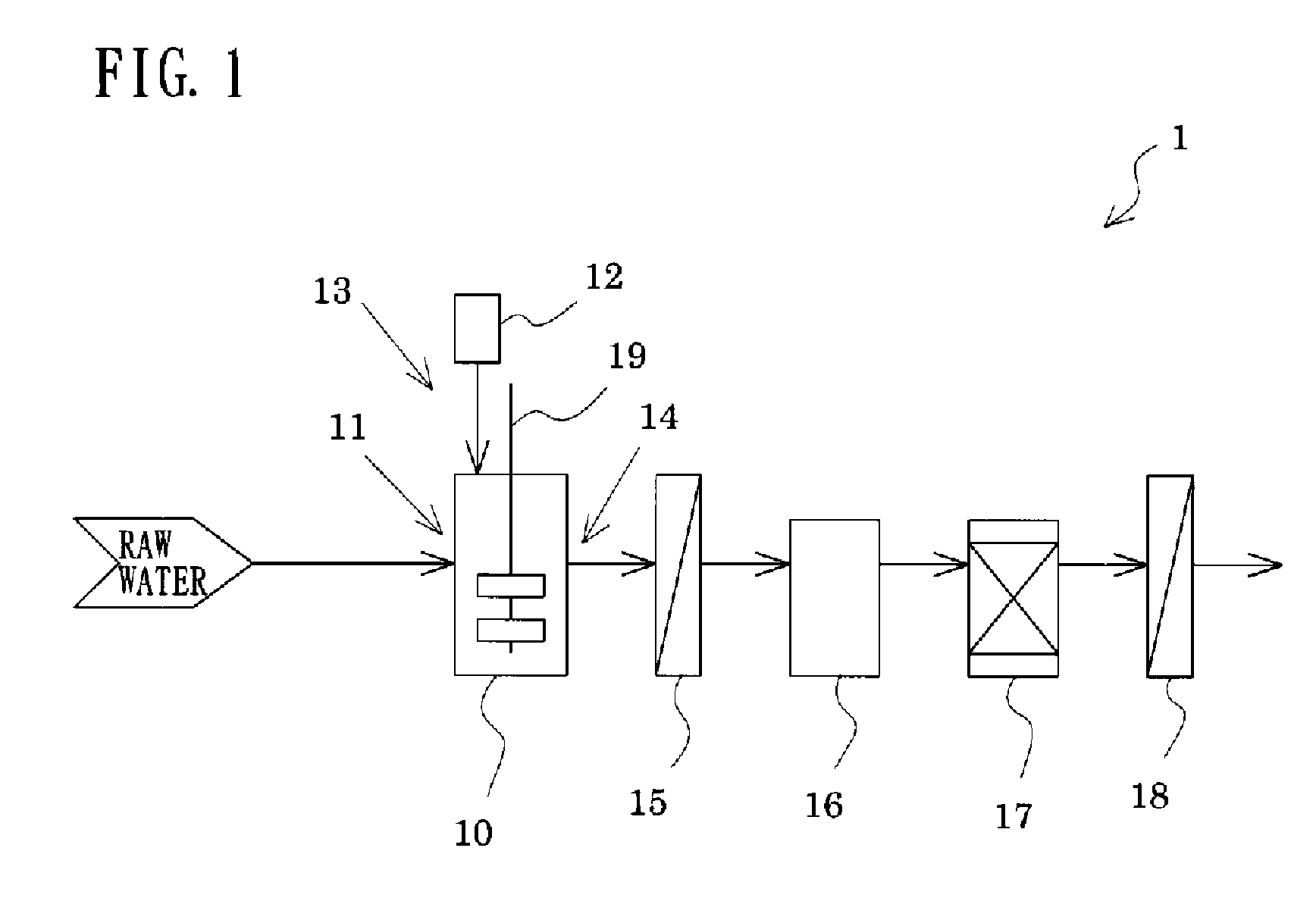Membrane separation method and membrane separation device
a membrane separation and membrane technology, applied in the field of membrane separation methods and membrane separation devices, can solve the problems of problematic deterioration in membrane separation performance, and achieve the effects of reducing stirring time, suppressing deterioration in membrane separation performance, and reducing the time of stirring
- Summary
- Abstract
- Description
- Claims
- Application Information
AI Technical Summary
Benefits of technology
Problems solved by technology
Method used
Image
Examples
embodiment 1
[0041]The membrane separation method according to the present invention is characterized by comprising adding, to treatment water, a particulate cationic polymer which swells in water but does not substantially dissolve therein, and subjecting the treatment water to membrane separation.
[0042]The treatment water contains a substance which fouls the membrane employed in membrane separation (membrane-fouling substance) carried out on the downstream side, for example, a humic acid-containing organic substance, a fulvic acid-containing organic substance, a bio-metabolite such as sugar produced by algae, etc., or a synthetic chemical such as a surfactant. However, no particular limitation is imposed on the type of treatment water, and specific examples include industrial water, city water, well water, river water, lake water, and industrial wastewater (in particular, industrial wastewater which has been subjected to biological treatment). The term “humus” refers to a degraded substance wh...
example 1-1
[0077]Industrial water containing humus and bio-metabolites was employed as treatment water and placed into flocculation jars (1,000 mL / jar). To each jar, a particulate cationic polymer which swells in water but does not substantially dissolve therein (Accogel C, product of Mitsui Sytec Ltd.) was added at a concentration of 0.5, 1, 2, 4, or 10 mg / L (as Accogel C), and the water sample was stirred.
[0078]Subsequently, the particulate-polymer-added treatment water sample water was filtered by means of a Buchner funnel (outer diameter of perforated plate: 40 mm, height of filtration portion: 100 mm) employing a membrane filter (Millipore) (diameter: 47 mm, micropore size: 0.45 μm) such that the filtration portion on the perforated plate was continuously filled with water. The time required for recovering 500 mL of filtrate (T1 (sec)), and the time required for recovering 1,000 mL of filtrate (T2 (sec)) were measured. The MFF value of the sample at each Accogel concentration was calculat...
example 1-2
[0079]The procedure of Example 1-1 was repeated, except that Accogel C was changed to anion-exchange resin (WA20, product of Mitsubishi Chemical Co., Ltd., particulate cationic polymer which swells in water but does not substantially dissolve therein), and the anion-exchange resin concentration was adjusted to 0.5, 1, 2, 4, 10, and 20 mg / L.
PUM
| Property | Measurement | Unit |
|---|---|---|
| Time | aaaaa | aaaaa |
| Angle | aaaaa | aaaaa |
| Angle | aaaaa | aaaaa |
Abstract
Description
Claims
Application Information
 Login to view more
Login to view more - R&D Engineer
- R&D Manager
- IP Professional
- Industry Leading Data Capabilities
- Powerful AI technology
- Patent DNA Extraction
Browse by: Latest US Patents, China's latest patents, Technical Efficacy Thesaurus, Application Domain, Technology Topic.
© 2024 PatSnap. All rights reserved.Legal|Privacy policy|Modern Slavery Act Transparency Statement|Sitemap



